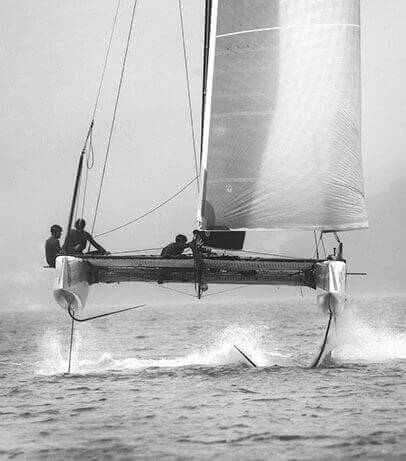The Billionaire's Boat Race
How the America’s Cup is won and lost
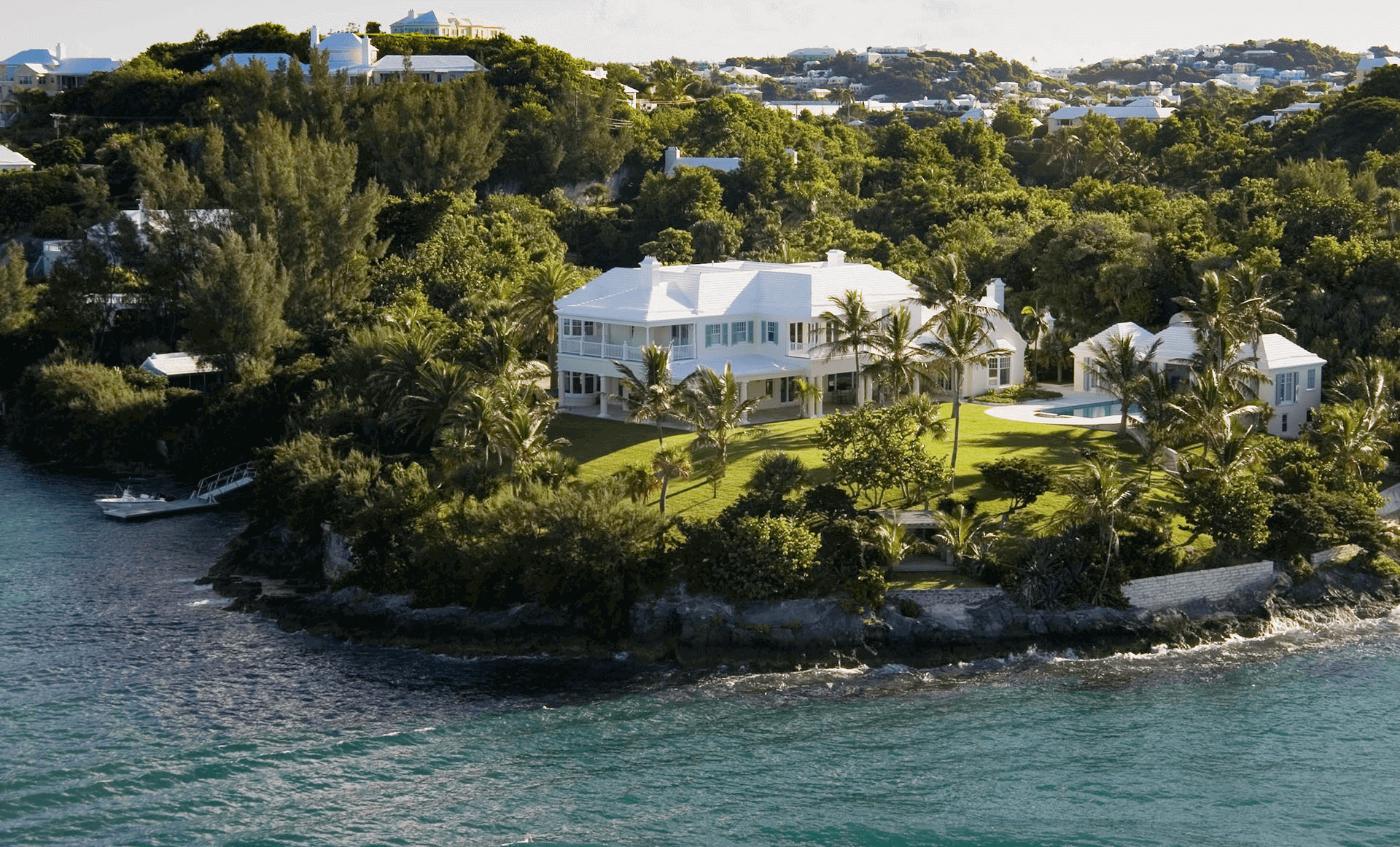
The greatest race of all time
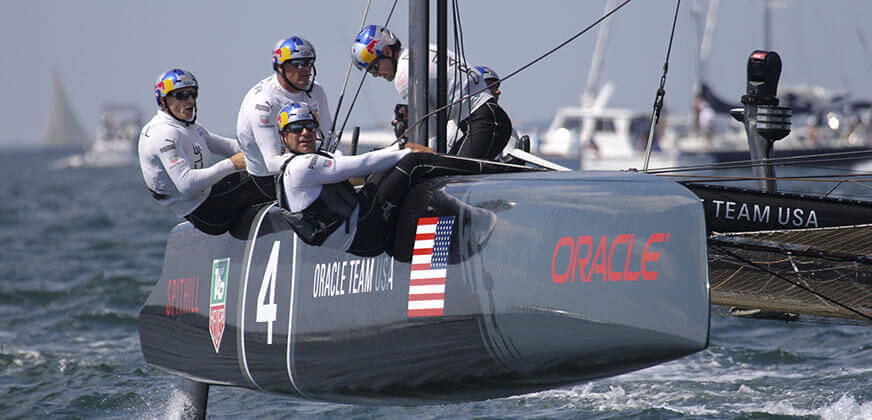
The America’s Cup is the oldest trophy in international sport. Since 1851, two teams of elite sailors have battled for boating’s most prestigious prize every few years. Somewhere between Formula One and chess - with the added unpredictability of wind and water - each America’s Cup sees the previous winner defend the cup against a challenging team in a series of head-to-head races.With campaigns costing millions of dollars, failure is not an option.
Overcoming the odds
The odds are stacked against the challenger from the start; the defender gets to pick where and when the next race is held and what type of boat is used.
- Only 6 out of 34 Cups (18%) have been won by the challenging club.
Nations that have won the Cup:
- USA: 29 wins
- New Zealand: 3 wins
- Switzerland: 2 wins
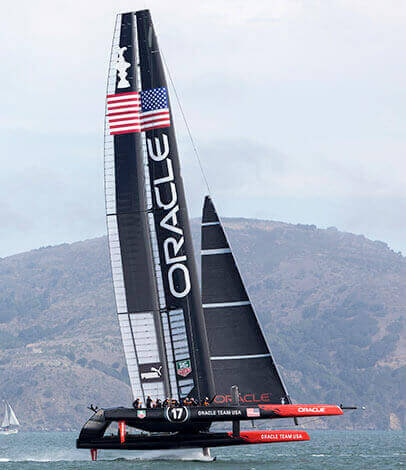
Race format for 2017
There is only one place up for grabs in the America’s Cup, so challenging teams must compete in a series of qualifying stages for their place in the main event.
Stage
What?
When?
Where?
What is it worth?
America’s Cup World Series
A series of races between all teams, including the defender
July 2015 – July 2016
Locations around the world
Bonus points for the next stage
America’s Cup Qualifiers
A double round-robin tournament between all challenging teams
Q1 2017
Bermuda
A place in the Challenger Playoffs and a one point advantage in the America’s Cup Match for the team with the most points
Challenger Playoffs: Semi-final
The top four challenging teams race each other head-to-head in a first-to-five format
May/June 2017
Bermuda
A place in the playoff final
Challenger Playoffs: Final
A head-to- head between the two winners of the semi-finals
May/June 2017
Bermuda
A place in the America’s Cup Match
America’s Cup Match
A first-to-seven showdown between the defender and the winner of the Challenger Playoffs
June 2017
Bermuda
America's Cup

The Teams
The defender:
Oracle Team USA (USA)
The challengers:
Artemis Racing (Sweden)
Ben Ainslie Racing (UK)
Emirates Team NZ (New Zealand)
Team France (France)
Softbank Team Japan (Japan)
Luna Rossa and Team Australia have since withdrawn their challenges.
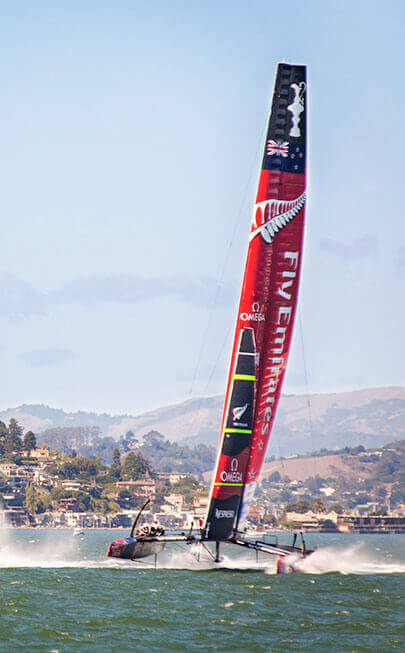
The Backstory
Oracle came back from 8-1 down in 2013’s Americas Cup in one of the greatest comebacks in sporting history. After losing four of the first five races, Oracle called a timeout and replaced their tactician with British Olympian Sir Ben Ainslie to overturn the deficit.
One year later, Ainslie announced to the world his plan to bring the America’s Cup back to Britain for the first time ever, launching Ben Ainslie Racing to compete for the 35th America’s Cup, taking place in 2017.
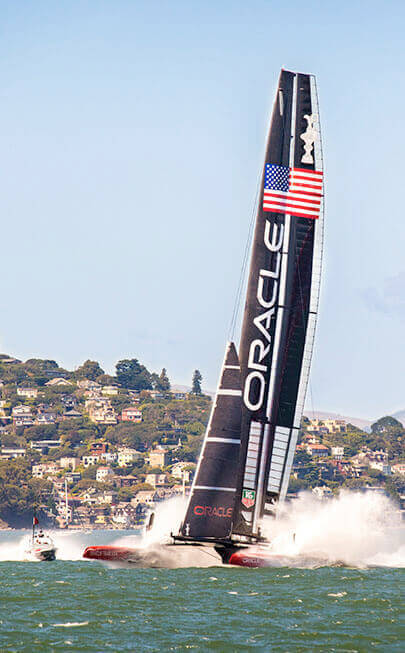
The role of technology
Cutting-edge technology has been at the heart of the America’s Cup since its inception and in the most cases, the Cup is won by the team with the fastest boat.
Technology Timeline
- 1899: The 11th America’s Cup is captured on camera by Thomas Edison.
- 1956: Less expensive 12-meter yachts are introduced to reignite interest in the Cup and end a 19-year gap.
- 1983: Australia II is the first boat to use a fin-like winged keel to be as light and steady as possible when sailing upwind.
- 1986: New Zealand Challenge’s KZ-7 monohull – nicknamed ‘Plastic Fantastic’ – replaces the traditional wood or aluminium hull with light- weight fibre-glass.
- 1987: The British-built Blue Arrow is the first foil-assisted boat.
- 1992: Helicopters are used to capture steady aerial shots for television coverage.
- 2010: Oracle’s USA-17 features a rigid 223ft wing sail made from carbon fiber rather than a traditional cloth sail that looked – and functioned – like an upright airplane wing.
- 2013: Foiling 72ft catamarans boost the top speed of previous races from around 20 mph to more than 55 mph.
Oracle's Innovations
The AC72 catamaran built by Oracle for 2013 was the fastest boat the America’s Cup had ever seen, reaching top speeds of 55 mph, which is approximately 2.8x faster than the wind.
- 3,000 variables ran at 10 times a second while sailing.
- 300+ sensors collected performance data and transmitted it to a server in the hull.
- 200 gigabytes of video footage pulled from the boat each day.
- 150 key parameters transmitted in real-time to a database on the chase boat.
- Four-man crew dedicated to real-time data analysis.
- Up to 30 devices worn by crew members to receive performance data.
- Custom software used to package historical race data for analysis.
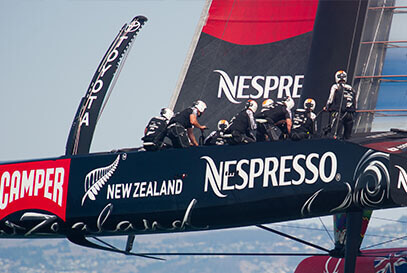
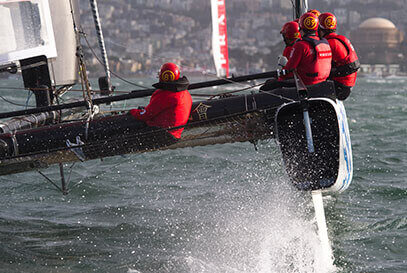
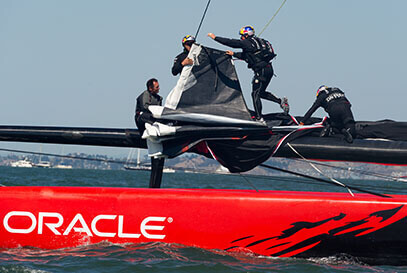
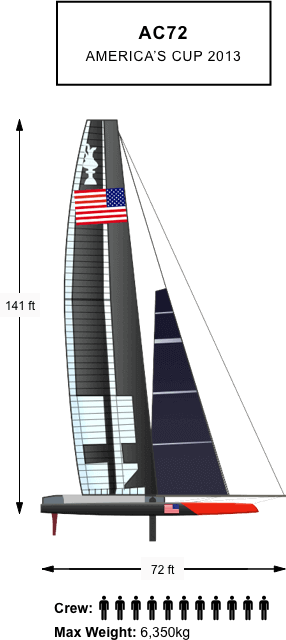
The billionaire’s boat race
Consecutive wins by Oracle – funded by Larry Ellison, the fifth richest person in the world – in 2010 and 2013 would suggest that the America’s Cup is won by the team with the biggest budget. However, changes to the rules for the next event should see the emphasis return to tactics and sailing skills.
The AC62 boat (named after its 62ft length) was initially chosen by Oracle for 2017, but a change was made in April 2015 in favour of the smaller – and cheaper – AC48 in an attempt to democratise the event and encourage more entrants.
“Our aim is to develop the Cup from a rich man’s sport to a sustainable grand prix event”
- Jimmy Spithill, captain of Oracle.

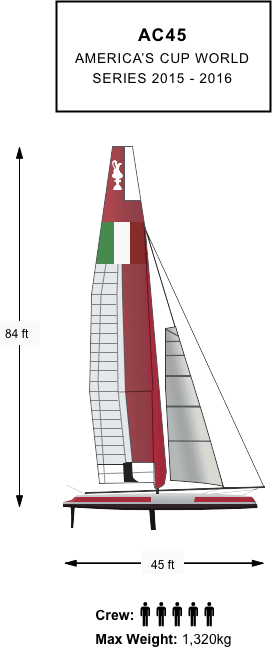
Whereas Oracle executives admitted to spending $115 million on winning the America’s Cup (some media speculation goes as high as $300 million), Franck Cammas, the captain of Team France told Yachting World that he thought it would be possible to challenge for the Cup with a budget of €15-€20 million ($16.7-$22.3 million).
However, despite costing a fraction of the price, the AC62 is still expected to reach the same speeds as the AC72s used in 2013.
For the America’s Cup World Series – which takes place is locations such as Portsmouth, UK; Gothenburg, Sweden; and Hamilton, Bermuda – teams will race in AC45s, which are shorter still.

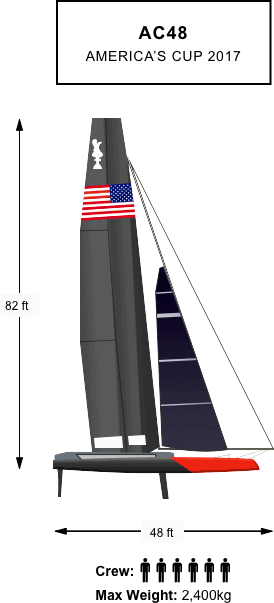
Requirements for the AC48:
- Two hulls connected by cross structure and arranged symmetrically about the yacht centerplane
- One wing and no more than one jib
Requirements for each hull:
- One rudder
- One rudder wing
- One daggerboard
- No other appendages

The price of victory
Estimated amount spent by Oracle in 2013:
$115 million according to Oracle executives.
$250-$300 estimated in the media.
$10+ million spent on building the Cup-winning boat.
$300,000: Annual salary for a low-ranking sailor
Estimated budgets for challenging teams in 2013:
$140 million: Artemis Racing
$100 million: Emirates Team NZ
$85 million: Luna Rossa Challenger
How does spending in the America’s Cup compare to other sports?
-

Formula One: $400 million spent by Ferrari in 2013.
-

Soccer: $310 million spent by Manchester City on player salaries in 2013.
-
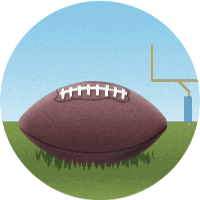
NFL: $146 million spent by Miami Dolphins in 2013 free agency period.
-

Basketball: $99 million spent by LA Lakers in 2012-13 wage bill.
-

NASCAR: $20-$40 million estimated budget for a top team.
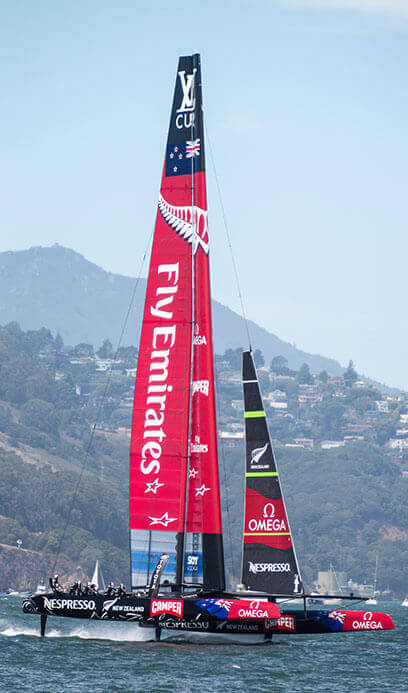
Outside Influencers
The competing teams in the 2017 race have partnered with some of the world’s most famous manufacturers from the aerospace and automobile industries.
Artemis Racing is working with the likes of Altair and Cosworth; Oracle made headlines by announcing a partnership with Airbus; Emirates Team NZ is sponsored by Emirates and Toyota; and perhaps most interestingly Ben Ainslie Racing is backed by Land Rover - as well as Red Bull Advanced Technologies - which was seen as something of a coup by the sailing press.
Furthering the sport's links with Formula One, Ainslie also hired Martin Whitmarsh, former CEO of McLaren Racing, as CEO.
Tactics and Talent
The America’s Cup is much more than a technological arms race. Each team assembles the best crew they can afford and constructs precise ‘playbooks’ full of chess-like tactics for every situation.
Faster than the wind
Sailors travel faster than the wind using the physics that allow an airplane to fly.
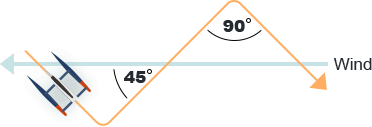
When sailing upwind, the boat can cut through the true wind at an angle – using a technique known as tacking – to create a powerful force.
They use both natural or ‘true’ wind, which pushes the boat, and the ‘apparent’ wind created by the boat’s movement, which pulls it.
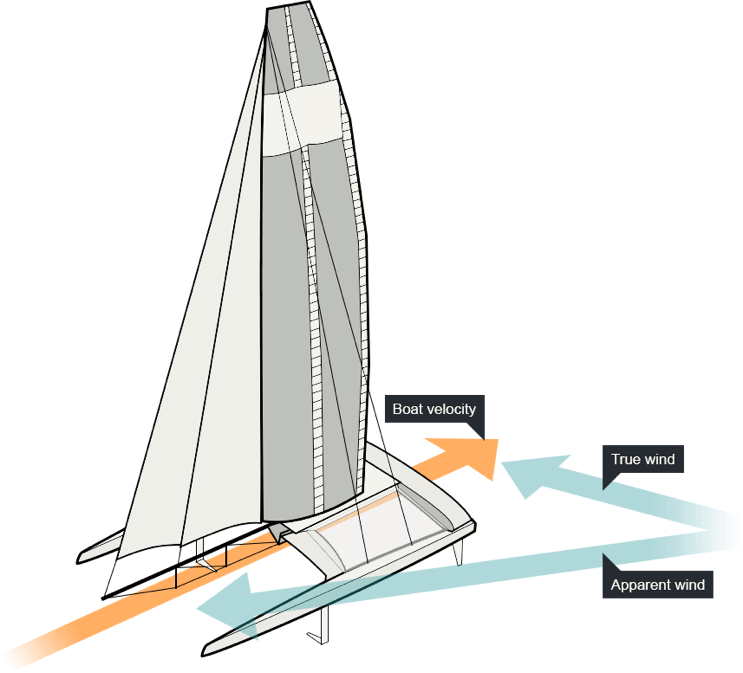
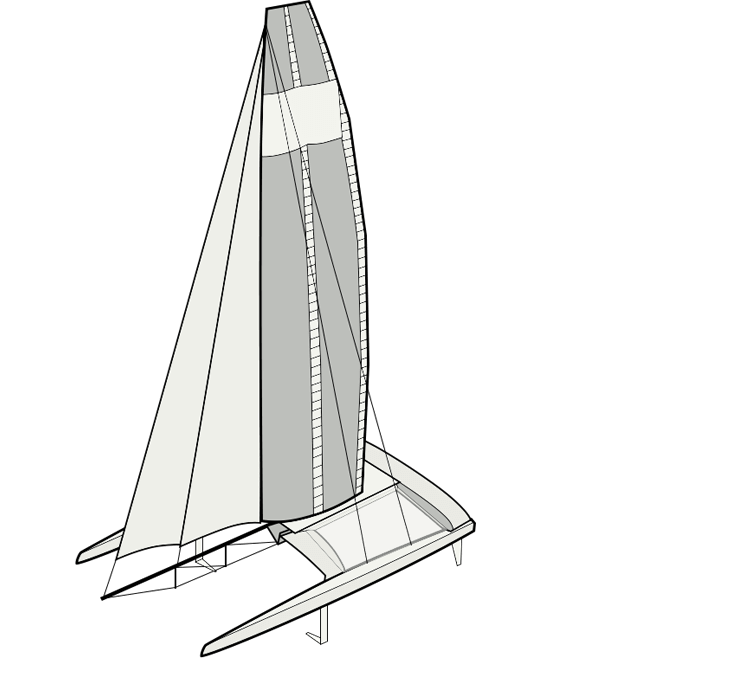





Turning the boat
There is no way to take down a wind sail, so every person on the team must work together to turn the boat when tacking. Turning the boat at high-speed is very difficult - a small mistake from a crew member could cause the boat to capsize.
Crew members – known as grinders – turn hand-cranks to power the system that moves the sail.
Other members pull ropes to adjust the angle of the boat.
The captain spins the helm at the exact right moment.
All sailors then rush from one hull to the other across a large trampoline netting.
Getting the angles right
Sailors turn the boat at a roughly 45 degree angle to the wind.
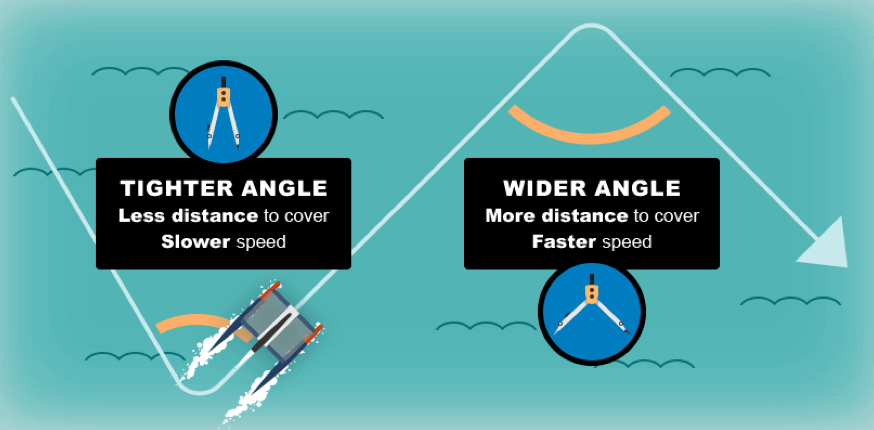

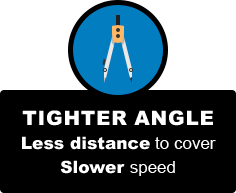
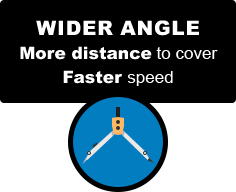

What to look forward to in 2017
It is said that Oracle’s Larry Ellison wanted to reinvent the America’s Cup as an extreme sport and that is precisely what he’s done.
Purists will tell you that moving away from the majestic monohulls that made previous Cups such a spectacle has cost the sport its soul, but you won’t find a more riveting race than the one that took the world by storm in 2013.
Could we see the same levels of drama in Bermuda? The chance to watch the world’s best sailors wage gravity-defying war on water is something you won’t want to miss.
References
- http://www.bbc.co.uk/sport/0/sailing/24285864
- http://www.yachtingworld.com/blogs/matthew-sheahan/ben-ainslie-racing-race-course-reconnaissance-62888
- http://www.wsj.com/articles/SB10001424052702303393804579312803907849782
- http://www.cupinfo.com/en/americas-cup-2017-dates-and-schedule-detailed-01.php
- http://www.americascup.com/en/news/131_Bermuda-is-the-home-of-the-2017-America-s-Cup.html
- http://www.reuters.com/article/2013/09/17/us-sailing-americascup-innovation-idUSBRE98G0O420130917
- http://www.forbes.com/sites/groupthink/2013/09/05/unsung-heroes-of-the-americas-cup/
- http://www.news.johnclaridgeboats.co.uk/2014/11/the-americas-cup-first-foil-assisted.html
- http://www.nshof.org/index.php?option=com_content&view=category&id=179:science-of-the-34th-americas-cup
- http://www.telegraph.co.uk/sport/othersports/sailing/10335496/Americas-Cup-how-the-yachts-go-faster-than-the-wind.html
- http://realbusiness.co.uk/article/24276-5-ways-big-data-won-the-americas-cup-for-ainslie-and-oracle-team-usa
- http://www.yachtingworld.com/blogs/matthew-sheahan/35th-americas-cup-announced-171
- http://ac.mueva.eu/media/files/m377_ac-class-rule-v1.pdf
- http://howtospendit.ft.com/boats/85761-americas-cup
- http://ww2.kqed.org/science/2013/09/11/how-do-these-boats-sail-faster-than-the-wind/
- http://www.onemetre.net/Design/AppWind/appwind.htm
- http://uk.businessinsider.com/larry-ellison-pays-sailors-on-his-americas-cup-team-300000-201
- http://www.sailingscuttlebutt.com/2013/09/26/cost-compete-34th-americas-cup/
- http://www.nytimes.com/2013/11/23/sports/autoracing/in-formula-one-deep-poc
- http://metro.co.uk/2013/12/09/how-well-did-manchester-city-spend-their-90million-in-the-summer-4224124/
- http://www.sbnation.com/nfl/2014/3/17/5508050/2014-nfl-free-agency-broncos-saints-big
- http://ballislife.com/nba-team-salaries-for-2012-2013/
- http://www.engadget.com/2013/03/13/exploring-nascars-technological-dichotomy/
- http://www.yachtingworld.com/blogs/matthew-sheahan/new-americas-cup-class-revealed-think-46-knots-in-16-knots-of-wind-and-thats-just-the-start-63197
